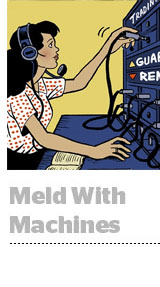 The term “programmatic” is contentious even among its faithful adherents. Not only does it inadequately describe a range of ad-buying activities, it also implies that everything is done automatically, as if robots are replacing a human sales staff.
The term “programmatic” is contentious even among its faithful adherents. Not only does it inadequately describe a range of ad-buying activities, it also implies that everything is done automatically, as if robots are replacing a human sales staff.
But a panel during the Premium Programmatic 360 summit (presented by Sonobi and MediaMath) held Wednesday in New York City emphasized that the most effective programmatic implementations are inherently cybernetic: part human, part machine.
“The human element will always be fundamental,” said Rick Greenberg, CEO of Kepler Group, a digital agency that spun off from MediaMath. The machine elements of programmatic enable scalability of real-time buying activities. “You still have machines making decisions in the moment,” Greenberg said. “But humans can inform that decisioning.”
Added Chip Schenck, VP of programmatic sales and strategy at publisher Meredith Corporation: “There’s a place for human decisioning and machine decisioning – but it’s all tech-enabled.”
Advertisers, agencies and vendors seeking to push programmatic principles into an ad sales unit have the unenviable task of communicating those benefits to individuals who aren’t always interested in hearing about it.
“[Programmatic] is definitely perceived as a threat,” said Rob Byrnes, SVP of pricing and planning at media holding firm Gannett Company. One hurdle is channel conflict: Sales staff see programmatic as competition for client dollars. This is the wrong tack to take, Byrnes said.
“I see programmatic transitioning from a sales channel to a sales tool,” he explained. “It’s about education. Getting your sales team on board to understand that programmatic isn’t the enemy. It’s a better way of delivering to your audience.”
Specifically, this entails adding relevancy to media buys.
“The homepage takeovers and the whiz-bang units will be there, but programmatic will come into the conversation as a sales tool,” Byrnes said.
So how to broach that conversation? Ray Reid, North America head of programmatic at Neo@Ogilvy, avoids drawing attention to the machinery that powers programmatic. Instead, he focuses on the material benefits programmatic brings.
“We try not to talk about the technology or the platform,” he said. “We try to talk about the benefits this ecosystem brings to the table. It’s a tremendously complex ecosystem, so clients don’t have the time or the desire to get to that level of detail. We talk about the capabilities the tech enables in terms of [clients] achieving their brand objectives.”
It’s a strategy that appeals to senior marketers, Reid said. Starting by extolling the technology or describing the tech ecosystem will cause a massive tune-out. Only after the top-level marketers buy in and you can engage with employees who are actively overseeing the digital campaigns should the conversation turn technical.
These conversations are important to continue as programmatic matures. In recent years, programmatic has moved from its strict confines as an RTB remnant play to the point where it’s beginning to touch more valuable, “premium” inventory and even the branding campaigns that constitute the bulk of online advertising spend.
“[As brands] start to see how we can progress people through the funnel, it becomes very powerful and interesting to them,” Greenberg said. “What will tip the scales for certain brand advertisers is the availability of more high-impact units.”
Admittedly he said, some brands like CPGs, who sell through intermediaries like retail outlets, won’t approach programmatic the same way as brands that sell directly to consumers. But in an omnichannel world, even CPGs can reap the benefits of programmatic.
“We look at programmatic as an efficient means to access another touchpoint in front of the consumer,” Reid said. “How many touches will somebody need to see before they convert? If we can find a way to increase the frequency of impressions in front of that right audience, programmatic enables us to do that … as it pertains to the overall [campaign] and not just the conversion online.
“You might not sell soap online, but you’ll want to deliver an impression in front of an audience. That might be one touch. A billboard will be another touch. The fact that we can talk about one metric will bring more brand managers into programmatic.”













